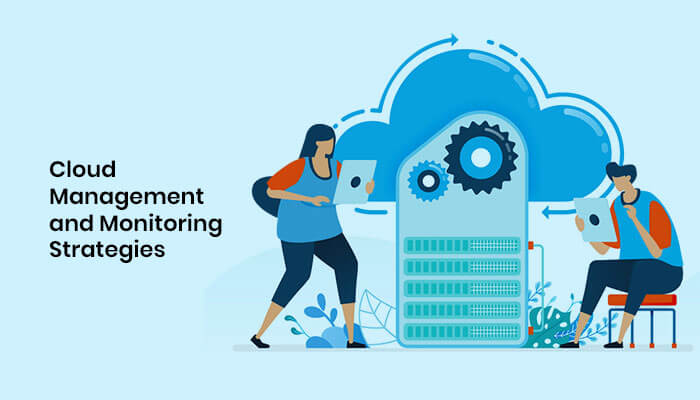We are past the era when enterprises had their software and hardware in data centers on- premise. The globalization of workforce and collaboration between corporations worldwide have necessitated the need for businesses to shift their applications and workload to data clouds. Clouds provide easy accessibility and exchange of data among all authorized users from any location with internet facility. Some common examples of cloud apps would be Email accounts and Dropbox, which we use to store and transfer files.
The increasing popularity and use of cloud services by organizations has led to an emerging need for cloud management. Cloud management is a necessary practice for companies today due to high use and demand of cloud-based services. Using the cloud to store data, applications, tools, and servers has enabled businesses and corporations to minimize time and maximize productivity levels. However, as cloud computing takes over on- premise IT services, it becomes crucial that its management and efficiency is given attention.
Before we discuss cloud management and its benefits, let us first briefly understand cloud computing.
What is Cloud Computing?
Cloud computing has changed the nature of IT services across industries. It is a method which enables customers to use infrastructure and applications via the internet, without having to install or maintain them on premises. It provides on-demand access via the internet to computing resources such as applications, servers, data storage, development tools, networking capabilities and more. It is implemented with the help of a cloud service provider (CSP) on a monthly subscription basis or even as per project package.
IaaS (Infrastructure-as-a-Service), PaaS (Platform-as-a-Service) and SaaS (Software-as-a-Service) are the common models of cloud services. Organizations are generally seen using all three models.
Data science service providers can work globally and produce data analyses and reports for businesses with the help of cloud computing technology. Companies have the option to outsource data science service providers and receive data mining, data analyses and business insights. These services require expert techniques and skills and it is often difficult to hire an inhouse professional to perform these tasks. However, having information provided by data scientists helps businesses in their core decision making and influence growth plans.
What is Resource Management in Cloud Computing?
Resource management in cloud computing is a process of distributing computing, storage, networking and energy resources to set up applications with the aim of achieving objectives and meeting the requirements of infrastructure providers and cloud users. It is a core functionality required within cloud systems. An improper resource management will reflect poorly on cost and performance. It often has an indirect impact on system functionality as well.
Cloud management
Cloud management is a process which helps organizations in maximizing the use of clouds while being cost efficient. Companies today have the option of using a private cloud, public cloud or a hybrid cloud model (which is a combination of public and private). This makes the presence of cloud management platforms a necessity to manage and control usage. Cloud management practices allow organizations to make informed decisions and provide information on how and when to use cloud-based services and make it cost friendly. It is because of cloud management that IT managers are able to move workloads through different clouds and manage the expenses incurred by cloud resources.
Monitoring usage establishes a baseline in the cloud management process. A cloud monitoring strategy provides a clear picture of its usage and associated costs. Once we have an idea of the cloud usage within the company, it becomes possible to move workloads within a multi cloud environment. With the help of cloud management software, the workload shift becomes automated among private and public clouds.
What is a Cloud Management Platform?
Common cloud management platforms provide data, content, and application management with easy automated processes while identifying cost differences and monitoring performance.
– Cloud data management
Storing data in the cloud is often a disaster recovery strategy. This process is automated with the help of cloud management tools.
– Cloud content management
In a multi cloud model, you can store data on different clouds in accordance to their requirement and accessibility. For example- content that needs to be archived and is less likely to be used regularly can be stored in a low-cost cloud with higher latency.
– Cloud application management
Organization can monitor cloud native applications and scale up processing as and when it is necessary.
A cloud management software can collect all the necessary information which is required in order to decide the distribution of data between private and public clouds. Once that is established, the software can then monitor the results and optimize the use of multi cloud management. However, in case of public clouds the providers often have their own management software. They may not offer an insight into performance, and only offer basic reporting of cost and usage. Organizations must use a third-party tool for management if they are heavily dependent on public cloud services. On the other hand, IT administrators can use private cloud management software tools to allocate resources efficiently. They can ensure that no particular user is overwhelming the server with large workload requests.
Benefits of Cloud Management
– Ensuring compliance
An effective cloud management tool helps to oversee if any user and cloud configurations are out of compliance with corporate cloud use policies and guidelines. They can address and move towards resolving such issues.
– Better cloud cost management
One of the most evident and known advantages of cloud management is better cost management. IT experts in your organization can make decisions to invest in private and public cloud services based on the monitored usage and cost incurred by your company.
– Workflow automation
During peak seasons, organizations tend to move some of their work from private clouds to public clouds. Workflow automation provided within cloud management allows this transition to happen smoothly and automatically saving time and money.
– Informs the optimal cloud strategy
Insights and analyses provided by cloud management tools give an idea of the workload that is being processed and user experiences. Using this information to make changes while availing different types of cloud for different purposes and create a balance of workload that is offloaded in private, public and hybrid cloud services.
Best Practices for Cloud Monitoring Strategies:
Before we discuss the monitoring strategies enabling organizations today to make the most of their cloud management platforms, it is important to know about the common challenges that arise with cloud monitoring. A report by Gartner shows that 80% of the enterprises they surveyed were either completely ignorant or had significant gaps in monitoring their cloud-based solutions.
Some common challenges include:
Complexity
A multi- cloud set up means having to deal with multiple tools, dashboards and data sources which could pose difficulties while managing and monitoring the entire infrastructure.
Visibility
Organizations may be not to able to get a full view of their cloud environments.
Alert fatigue
Too many pop alerts from various monitoring tools can overwhelm IT teams and make them miss critical alerts in the process.
Cost
Businesses may find it hard to pay for the expensive monitoring tools and services.
Security
Safety of cloud infrastructure becomes a huge concern for companies as they have to deal with cyber-attacks, data breaches and insider threats often.
Compliance
Compliances such as General Data Protection Regulation (GDPR), Health Insurance Portability and Accountability Act (HIPAA) are sometimes challenging for companies to enforce and monitor.
Cloud Monitoring Best Practices Include the Following:
1. Single Platform to Monitor the Cloud and On-Premise Infrastructure:
In many cases businesses already have an on-premise infrastructure, so once they choose cloud services they must integrate the infrastructure with the new cloud environment. One of the best practices to adapt in cloud monitoring is the integration of metrics collected from your existing system with those collected from the cloud.
2. Monitor Consumption Levels
Monitoring usage can highlight the impact your cloud services are having on your IT infrastructure. It becomes essential that the cloud services being used also evolve as per the changing nature of your business’ requirements.
3. Monitor the End-user Experience
It is important to ensure that your cloud monitoring platform is aligned with the end-user experience tool. It enables you to gather insights on how and when users interact with cloud-based applications. The cloud monitoring system you are using should allow you to install alerts for your business needs. For example- an alert can notify you when a user experiences slow response time in a particular region.
4. Integrate Metrics and Flow Data
Cloud monitoring platforms should be able to integrate data spread across vendors and generate uniform metrics. This provides an overall view for your cloud deployment.
Apart from these cloud monitoring practices, it is a smart business decision to have a backup plan for cloud infrastructure, and ensure protection of all your end points by antivirus softwares, firewalls and other security measures.
Conclusion
Monitoring cloud environments is certainly a difficult task to accomplish, especially when you are investing heavily on home grown solutions. Outsourcing services from a cloud platform vendor can be a profitable solution for your growing business. The outsourcing service providers are acquainted with the latest changes and developments in cloud based platforms and can produce detailed reports. They can also suggest management techniques based on your business requirements and cloud models. Most service providers today assure complete ownership of data and prioritize security. Cloud management has become an integral part of organizations these days as they mostly operate and use cloud based applications and servers.







